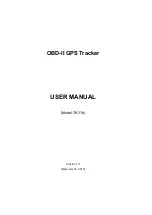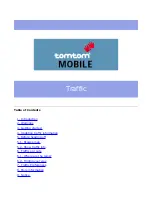
HSPA/UMTS
2100 (I)/1900 (II)/AWS 1700 (IV)/850 (V)/800 (VI, XIX)/900 (VIII) MHz
GSM/GPRS
850/900/1800/1900 MHz
The LMU-5541 utilizes Dual-Mode Bluetooth Classic and BLE 4.2
WiFi -
802.11 a/b/g/n/ac (2.4 GHz & 5GHz) (1x1) Supports access point and/or client operations (10 concurrent users)
LMU-5541 Hardware & Installation Guide
18/49
The activation sequence for a GSM LMU would therefore look as follows:
AT$APP PARAM 2306,0,“myAPN.myOperator.com”
AT$APP PARAM 2306,1,“myAPN.myOperator.com”
AT$APP PARAM 2314,0,“myUSername”
AT$APP PARAM 2315,0,“myPassword”
For a blank APN the following command can be used:
AT$APP PARAM 2306,0,“” (for a blank APN)
Only enter this next command if you have been given a non-zero PIN as any errors may lock you out of the modem.
AT$APP PIN <SIM pin>
You can confirm activation by watching the Comm LED to see if it goes solid. You may also confirm activation using
AT$APP COMM STATUS?
A good response should look similar to the following:
GSM Registered: Yes
GPRS Registered: Yes
Connection: Yes
RSSI: -70 dBm
BER: 0
Channel: 0
Cell ID: 0
Base Station ID: 0
Local Area Code: 0
Network Code: 38
Country Code: 310
IMEI (Modem S/N): 500167110060440
IMSI (SIM S/N): 310380100521849
Phone Number:
GPRS APN: IP:Public
Quality of Srvc: 1,0,0,3,0,0
GSM Class: B
5 Installing the LMU
The installation of the LMU and its antennas can have a major impact on the LMU’s performance. It is recommended that installers be familiar
with the installation of GPS and cellular devices and are comfortable in a vehicle
environment.
5.1 Preparing for Installation
Be sure you have received all the LMU components you need. This must include:
The LMU to be installed
A power harness
GPS Antenna (for external devices)
Comm Antenna (for external devices)
Optional Components:
Input and output cables
Relays
LMU peripherals (i.e. Serial adapter, jPOD, TetheredLocator)
Host serial devices (e.g. PDAs, laptops, other serial devices)
5.2 Plan The Installation
Verify Power, Ground and Ignition.
Be sure to check each source (power, ground and ignition) to ensure that the proper signaling exists. This
is typically accomplished with a multi-meter.
Before drilling any holes or running any wires, decide where each hardware component will be located (LMU, antennas, peripherals, etc.). Be
sure that the cables to the LMU are not bent or constricted in any way. Also
make sure that the LMU is kept free from direct exposure to the elements (sun, heat, rain, moisture etc...).
Be advised that an installation that violates the environmental specifications of the LMU will void the warranty.
The best way to ensure a trouble-free installation is to consider your options and make some decisions before you start. Take a look at the vehicle
and determine how to best install the LMU for the following purposes:
Accurate data gathering and simulation of how customers actually use your solution
LMU-5541 Hardware & Installation Guide
21/49
Ongoing monitoring and maintenance of LMU equipment
Accidental or intentional alteration of the equipment or cable connections
The following sections cover some of the issues to consider when planning your LMU installation.
5.2.1 Size and Placement of LMU Unit
The dimensions of the LMU should be taken into account, particularly when installing in a vehicle:
Whether you intend to place the LMU under a seat or into a cavity behind the vehicle’s interior molded trim, be sure the LMU will fit before
drilling any holes or running cable
Be certain that the cables running to the LMU will not be bent or constricted. Damage to the cables may impede the LMU’s performance.
Be certain that the installation point will not violate any of the LMU’s environmental specification (temperature, moisture, etc…) as improper
installation of the LMU may void the warranty.
See the LMU Environmental Specifications for the exact measurements and specifications of the LMU-5541
™
.







































